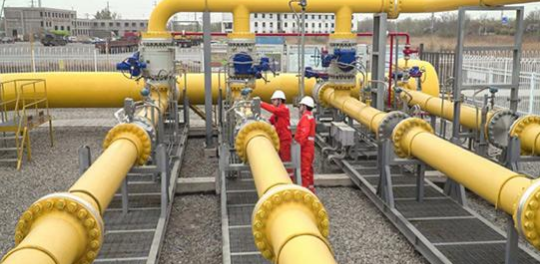The positioning and development path of natural gas power generation in the energy transition period
By the end of 2019, the installed capacity of full-caliber power generation in China was 2010.06 million kW, of which 90.24 million kW was gas power, accounting for about 4.5%[5]. In 2019, the apparent consumption of natural gas in China was 306.7 billion m3, of which 55.39 billion m3 was used for power generation, accounting for about 18.1%[4]. In the same year, natural gas power generation in the United States, the United Kingdom and Japan accounted for 38.63%, 40.1% and 35.0% of the total power generation respectively, and the gas consumption in power generation accounted for 36%, 31% and 69% of the natural gas consumption structure, respectively [3].
In 2019, China continued to maintain its position as the world's largest consumer and producer of renewable energy, with total renewable energy consumption equivalent to 2.2 times that of the United States (second in the world) and 3.2 times that of Brazil (third in the world). In 2019, China's consumption of renewable energy (water-based electricity) reduced CO2 emissions by 1.65 billion tons, equivalent to 16.5% of China's total CO2 emissions in that year [3]. Although China's renewable energy production scale ranks first in the world, the phenomenon of abandoning wind and light is still relatively serious. In 2019, the national abandoned wind and abandoned light power amounted to 16.9 billion kW∙h and 4.6 billion kW∙h respectively, which is equivalent to the annual power generation capacity of 4.5 million kW coal power plants, and the cost of coal burning is about 5 billion yuan and 6 million tons of CO2 emissions [6-7]. Overall, the flexibility of the power system in China varies, but it is difficult to meet the demand for a high proportion of renewable energy generation. In China, the proportion of flexible power supply such as pumped storage and gas power generation is only 6%, and the adjustment capacity of the power system is seriously insufficient. The "Three North" region with rich wind power and photovoltaic power generation has lower power scheduling flexibility, with the proportion of coal power installed capacity exceeding 70% and the proportion of flexible power supply accounting for less than 4%. The proportion of flexible power supply in countries with a high proportion of renewable energy is relatively high, and the proportion of flexible power supply in Spain, Germany and the United States (the proportion of renewable energy in primary energy consumption is 17.0%, 17.5% and 8.6%, respectively) accounted for 31%, 19% and 47% of the total installed capacity, respectively. Natural gas power generation is an important part of flexible power regulation.

With the increasing number and proportion of renewable energy such as photovoltaic and wind power into the power grid, the volatility and intermittency of renewable energy generation will also expand their impact exponentially, which will bring greater challenges to the safe and stable operation of the power system. The power grid needs a larger scale of fast response speed, affordable power generation cost, sustainable power supply to provide peak regulation and frequency modulation services. The system demand and supply are changing at any time, and the speed of change is different, and the power supply with different response speed is needed to supplement. Natural gas power generation has the advantages of flexible operation, short start-stop time, fast climbing rate and excellent adjustment performance. Compared with coal-fired power generation, pumped storage and battery energy storage, natural gas power generation is the most optimized peaking power supply with response characteristics, power generation cost and power supply continuity. The development of natural gas power generation with renewable energy will be the best way for the country's future energy transformation.
From high carbon energy to low carbon energy, from low carbon energy to fully renewable energy, this is the world's energy transition and development trend. We should follow this trend and shorten the process as much as possible, but we should respect the objective laws of this process and should not try to move from high carbon energy to low carbon energy to fully renewable energy in one step.
2. Gas-fired power generation has obvious advantages over coal-fired power generation
Compared with coal-fired power generation, gas-fired power generation is not only lower than coal-fired power generation in conventional pollutant emissions, but also better than coal-fired power generation in carbon emissions, peak load performance, investment, land area, water consumption and other aspects.
Gas power generation has a significant reduction in pollutant emissions compared with coal power generation
After years of strong investment and development, the "ultra-low emission" transformation of coal-fired power generation has significantly reduced the pollutant emissions of coal-fired power plants, and has made undeniable contributions to improving China's air quality. However, it should be clearly recognized that the "ultra-low emission" transformation of coal-fired power plants can barely match the NOx emission of gas-fired power plants. Such as SO2, CO2, soot, solid waste, heavy metals and other pollutants emissions are higher or much higher than gas power generation.
- EMERSON
- Honeywell
- CTI
- Rolls-Royce
- General Electric
- Woodward
- Yaskawa
- xYCOM
- Motorola
- Siemens
- Rockwell
- ABB
- B&R
- HIMA
- Construction site
- electricity
- Automobile market
- PLC
- DCS
- Motor drivers
- VSD
- Implications
- cement
- CO2
- CEM
- methane
- Artificial intelligence
- Titanic
- Solar energy
- Hydrogen fuel cell
- Hydrogen and fuel cells
- Hydrogen and oxygen fuel cells
- tyre
- Chemical fiber
- dynamo
- corpuscle
- Pulp and paper
- printing
- fossil
- FANUC
- Food and beverage
- Life science
- Sewage treatment
- Personal care
- electricity
- boats
- infrastructure
- Automobile industry
- metallurgy
- Nuclear power generation
- Geothermal power generation
- Water and wastewater
- Infrastructure construction
- Mine hazard
- steel
- papermaking
- Natural gas industry
- Infrastructure construction
- Power and energy
- Rubber and plastic
- Renewable energy
- pharmacy
- mining
- Plastic industry
- Schneider
- Kongsberg
- NI
- Wind energy
- International petroleum
- International new energy network
- gas
- WATLOW
- ProSoft
- SEW
- wind
- ADVANCED
- Reliance
- YOKOGAWA
- TRICONEX
- FOXBORO
- METSO
- MAN
- Advantest
- ADVANCED
- ALSTOM
- Control Wave
- AB
- AMAT
- STUDER
- KONGSBERG
- MOTOROLA
- DANAHER MOTION
- Bently
- Galil
- EATON
- MOLEX
- Triconex
- DEIF
- B&W
- ZYGO
- Aerotech
- DANFOSS
- KOLLMORGEN
- Beijer
- Endress+Hauser
- MOOG
- KB
- Moxa
- Rexroth


Email:wang@kongjiangauto.com

































































































